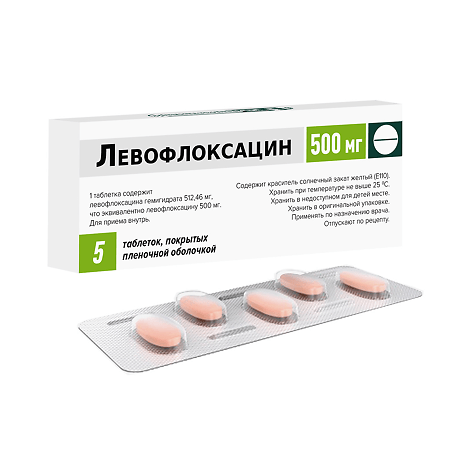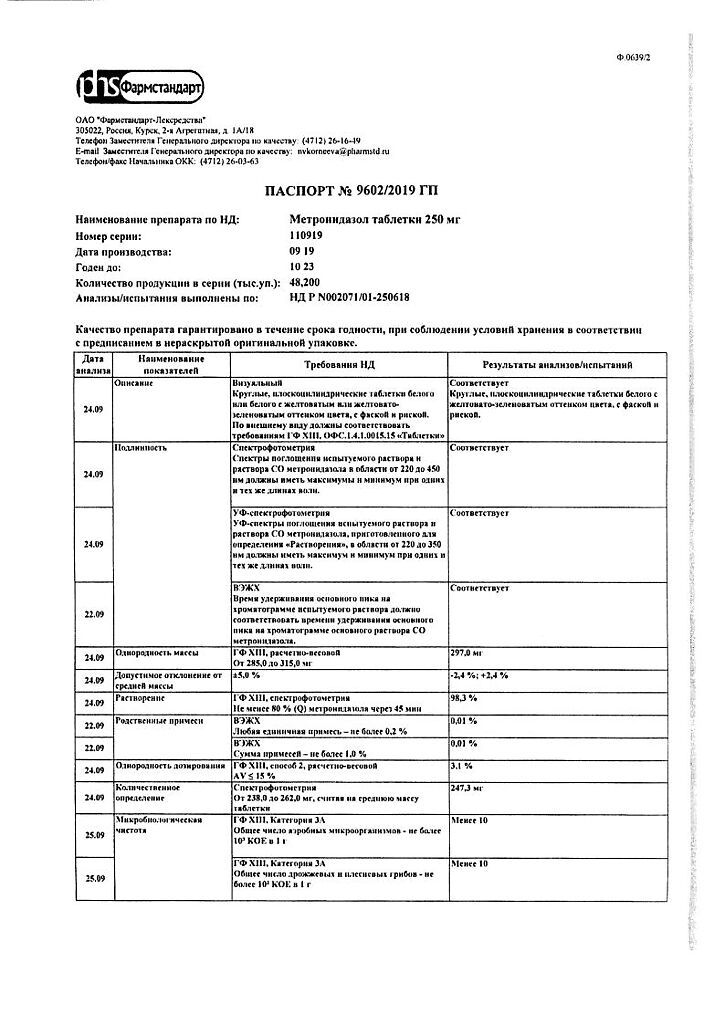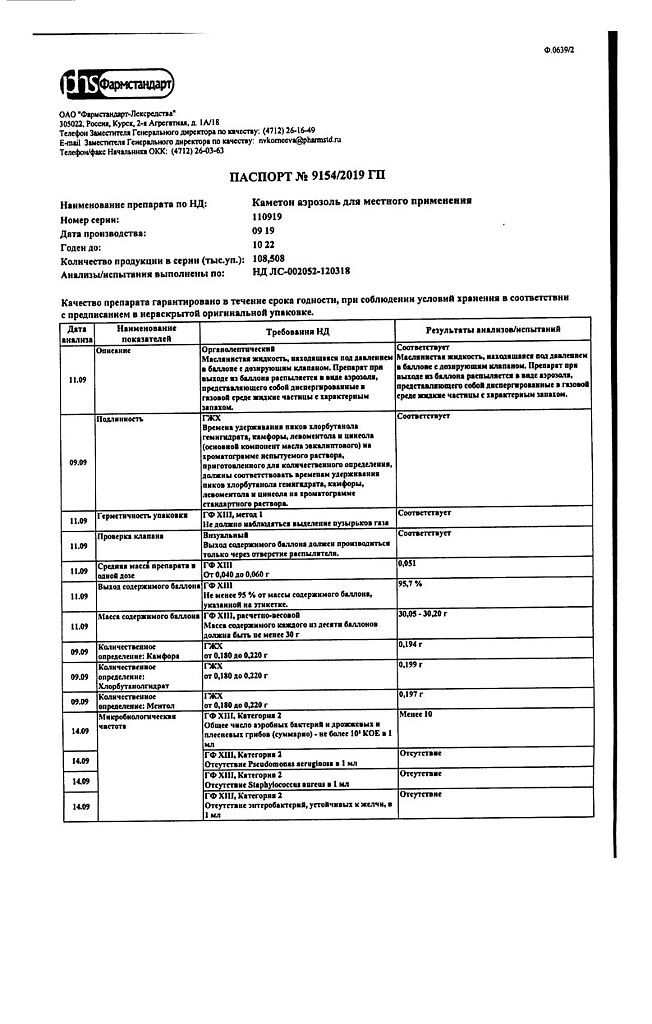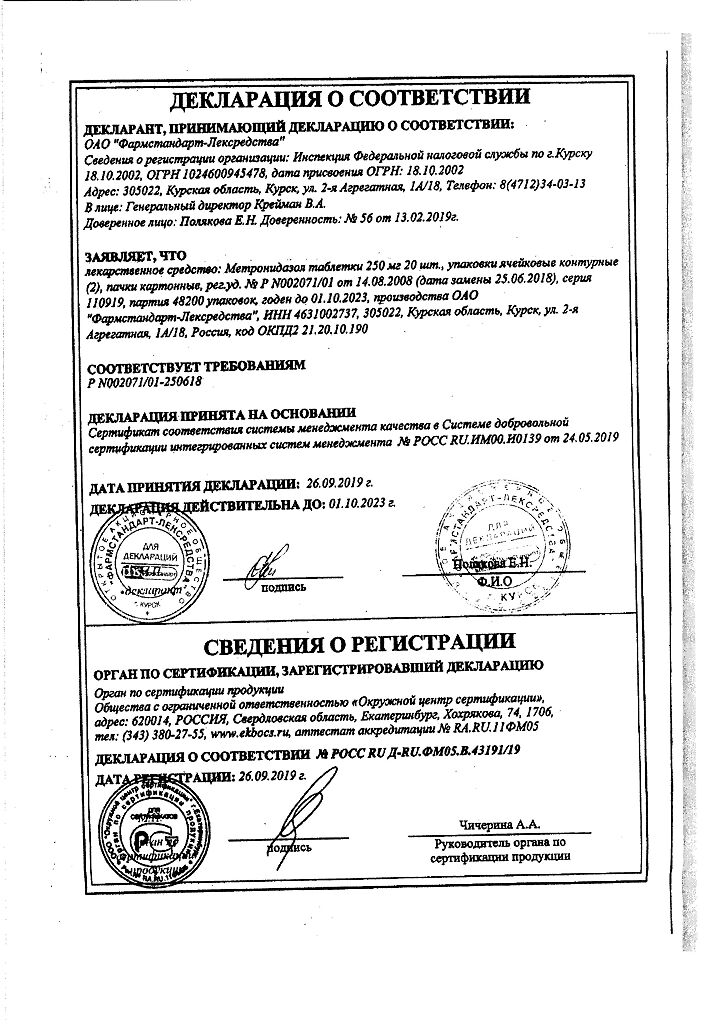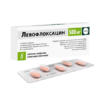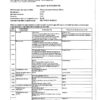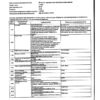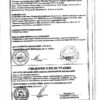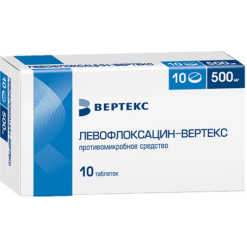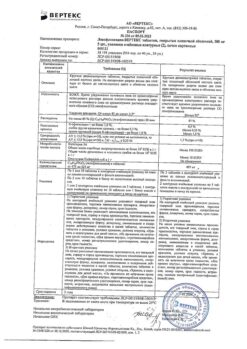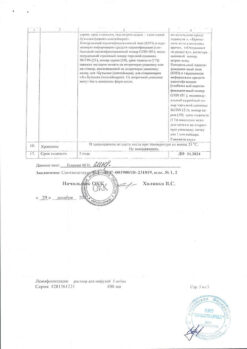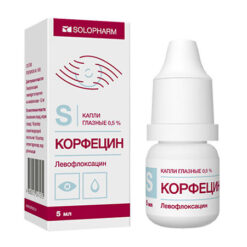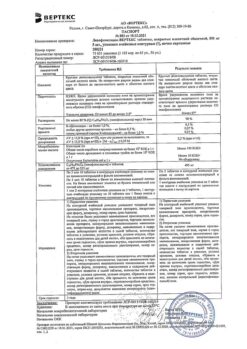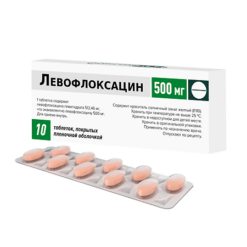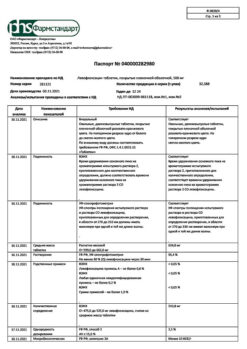No products in the cart.
Levofloxacin, 500 mg 5 pcs
€8.84 €7.74
Description
Pharmacotherapeutic group: Antimicrobial agent – fluoroquinolone
ATX code: J01MA12
Pharmacological properties
Pharmacodynamics
Levofloxacin is a synthetic broad spectrum antibacterial drug from the group of fluoroquinolones, containing levofloxacin – the left-handed isomer ofloxacin as the active substance. It blocks DNA-enzyme (topoisomerase II) and topoisomerase IV, breaks superspiralization and cross-linking of DNA breaks, inhibits DNA synthesis, causes deep morphological changes in cytoplasm, cell wall and membranes of sensitive microorganisms.
Levofloxacin is active against most strains of microorganisms both in vitro and in vivo.
In vitro
Sensitive microorganisms (MPC ≤ 2 mg/L; zone of inhibition ≥ 17 mm)
– Aerobic Gram-positive microorganisms: Bacillus anthracis, Corynebacterium diphtheriae, Corynebacterium jeikeium, Enterococcus spp. Enterococcus faecalis, Listeria monocytogenes, Staphylococcus coagulase-negativemethi-S(I) [coagulase-negative methicillin-sensitive/ moderately sensitive, Staphylococcus aureus methi-S (methicillin-sensitive), Staphylococcus epidermidis methi-S (methicillin-sensitive), Staphylococcus spp. CNS (coagulazonegative), Streptococci u G, Streptococcus agalactiae, Streptococcus pyogenes, Streptococcus pneumonia peni I/S/R (penicillin-moderately sensitive/sensitive/resistant), Viridans streptococci peni-S/R (penicillin-sensitive/resistant).
– Aerobic Gram-negative microorganisms: Acinetobacter baumanii, Acinetobacter spp., Actinobacillus actinomycetemcomitans, Citrobacter freundii, Eikenella corrodens, Enterobacter aerogenes, Enterobacter cloacae, Enterobacter spp, Escherichia coli, Gardnerella vaginalis, Haemophilus ducreyi, Haemophilus influenza ampi-S/R (ampicillin sensitive/resistant), Haemophilus parainfluenzae, Helicobacter pylori, Klebsiella oxytoca, Klebsiella pneumoniae, Klebsiella spp, Moraxela catarrhalis β+/β- (producing and non-producing beta-lactamases), Morganella morganii, Neisseria gonorrhoeae non PPNG/PPNG (not producing and producing penicillinase), Neisseria meningitidis, Pasteurella canis, Pasteurella dagmatis, Pasteurella multocida Pasteurella spp, Proteus mirabilis, Proteus vulgaris, Providencia rettgeri, Providencia stuartii Providencia spp. Pseudomonas aeruginosa (hospital infections caused by Pseudomonas aeruginosa may require combined treatment), Pseudomonas spp., Salmonella spp., Serratia marcescens, Serratia spp.
– Anaerobic microorganisms: Bacteroides fragilis, Bifidobacterium spp., Clostridium perfringens, Fusobacterium spp., Peptostreptococcus, Propionibacterium spp., Veilonella spp.
– Other microorganisms: Bartonella spp., Chlamydia pneumoniae, Chlamydia psittaci, Chlamydia trachomatis, Legionella pneumophila, Legionella spp., Mycobacterium spp., Mycobacterium leprae, Mycobacterium tuberculosis, Mycoplasma hominis, Mycoplasma pneumoniae, Rickettsia spp. , Ureaplasma urealyticum.
Moderately susceptible microorganisms (MPC = 4 mg/L; inhibition zone 16-14 mm)
– Aerobic Gram-positive microorganisms: Corynebacterium urealyticum, Corynebacterium xerosis, Enterococcus faecium, Staphylococcus epidermidis methi-R(methicillin-resistant), Staphylococcus haemolyticus methi-R (methicillin-resistant).
– Aerobic Gram-negative microorganisms: Campylobacter jejuni/coli.
– Anaerobic microorganisms: Prevotella spp., Porphyromonas spp.
Levofloxacin-resistant microorganisms (MPC > 8mg/L; zone of inhibition < 13 mm)
– Aerobic Gram-positive microorganisms: Staphylococcus aureus methi-R (methicillin-resistant), Staphylococcus coagulase-negative methi-R (coagulase-negative methicillin-resistant).
– Aerobic Gram-negative microorganisms: Alcaligenes xylosoxidans.
– Anaerobic microorganisms: Bacteroides thetaiotaomicron.
– Other microorganisms: Mycobacterium avium.
Resistance
Resistance to levofloxacin develops as a result of a stepwise process of mutations in the genes encoding both type II topoisomerases: DNA-Gyrase and topoisomerase IV. Other mechanisms of resistance, such as the mechanism of influence on the penetration barriers of the microbial cell (a mechanism characteristic of Pseudomonas aeruginosa) and the mechanism of efflux (active elimination of the antimicrobial agent from the microbial cell), can also decrease the sensitivity of microorganisms to levofloxacin.
In view of the specific mechanism of action of levofloxacin there is usually no cross-resistance between levofloxacin and other antimicrobial agents.
Clinical efficacy (effectiveness in clinical studies in the treatment of infections caused by the microorganisms listed below):
– Aerobic Gram-positive microorganisms: Enterococcus faecalis, Staphylococcus aureus, Streptococcus pneumoniae, Streptococcus pyogenes.
– Aerobic Gram-negative microorganisms: Citrobacter freundii, Enterobacter cloacae, Escherichia coli, Haemophilus influenzaemophilus parainfluenzae, Klebsiella pneumoniae, Moraxella (Branhamella) catarrhalis, Morganella morganii, Proteus mirabilis, Pseudomonas aeruginosa, Serratia marcescens.
– Others: Chlamydia pneumoniae, Legionella pneumophila, Mycoplasma pneumoniae.
Pharmacokinetics
Absorption
Levofloxacin is quickly and almost completely absorbed after oral administration; food has little effect on its absorption. Absolute bioavailability when administered orally is 99-100%. After a single use of 500 mg of levofloxacin maximum concentration in blood plasma (Cmax) is reached within 1-2 hours and is 5.2±1.2 µg/ml. Pharmacokinetics of levofloxacin is linear in the range from 50 to 1000 mg. The equilibrium state of plasma concentrations of levofloxacin when receiving 500 mg of levofloxacin 1 or 2 times a day is reached within 48 hours.
On day 10 of oral administration of 500 mg of levofloxacin once daily, the Cmax of levofloxacin was 5.7 ± 1.4 µg/ml, and the minimum plasma concentration of levofloxacin (concentration before the next dose) (Cmin) was 0.5 ± 0.2 µg/ml.
On day 10 of oral administration of 500 mg of levofloxacin twice daily, the Cmax was 7.8 ± 1.1 µg/ml and the Cmin was 3.0 ± 0.9 µg/ml.
Distribution
The binding to serum proteins is 30-40%. After single and repeated administration of 500 mg of levofloxacin the volume of distribution of levofloxacin averaged 100 l which indicates good penetration of levofloxacin into human organs and tissues.
Infiltration into the bronchial mucosa, epithelial lining fluid, alveolar macrophages
. After a single oral dose of 500 mg of levofloxacin, maximum concentrations of levofloxacin in bronchial mucosa and epithelial lining fluid were reached within 1 h or 4 h and were 8.3 µg/g and 10.8 µg/mL, respectively, with penetration rates in bronchial mucosa and epithelial lining fluid, compared to plasma concentrations of 1.1-1.8 and 0.8-3, respectively.
After 5 days of oral administration of 500 mg of levofloxacin, mean concentrations of levofloxacin 4 hours after the last drug administration in the epithelial lining fluid were 9.94 µg/mL and in alveolar macrophages were 97.9 µg/mL.
Pulmonary tissue penetration
The maximum pulmonary tissue concentrations after oral administration of 500 mg of levofloxacin were approximately 11.3 µg/g and were reached 4-6 h after drug administration with penetration ratios of 2-5, compared to plasma concentrations.
Perfusion in alveolar fluid
. After 3 days of administration of 500 mg of levofloxacin 1 or 2 times daily, maximum concentrations of levofloxacin in alveolar fluid were reached 2-4 hours after drug administration and were 4.0 and 6.7 µg/ml, respectively, with a penetration factor of 1, compared to plasma concentrations.
Bone penetration
Levofloxacin penetrates well into cortical and cancellous bone tissue in both the proximal and distal femur, with a penetration ratio (bone tissue/plasma) of 0.1-3. Maximum levofloxacin concentrations in the cancellous bone tissue of the proximal femur after oral administration of 500 mg of the drug were approximately 15.1 µg/g (2 hours after drug administration).
Cerebrospinal fluid penetration
Levofloxacin poorly penetrates into the cerebrospinal fluid.
Permeasurement in prostate tissue
After oral administration of 500 mg of levofloxacin once daily for 3 days, the average concentration of levofloxacin in prostate tissue was 8.7 µg/g and the average prostate/plasma concentration ratio was 1.84.
Urinary concentrations
The mean urinary concentrations 8-12 h after oral doses of 150, 300, and 600 mg of levofloxacin were 44 µg/mL, 91 µg/mL, and 162 µg/mL, respectively.
Metabolism
Levofloxacin is metabolized to a small extent (5% of the dose taken). Its metabolites are demethyllevofloxacin and levofloxacin N-oxide, which are excreted by the kidneys. Levofloxacin is stereochemically stable and does not undergo chiral transformations.
Levofloxacin is relatively slowly eliminated from the blood plasma after oral administration (elimination half-life (T1/2) is 6-8 hours). Excretion is mainly through the kidneys (more than 85% of the dose taken). Total clearance of levofloxacin after a single dose of 500 mg was 175 ± 29.2 ml/minute.
There are no significant differences in the pharmacokinetics of levofloxacin when administered intravenously and when administered orally, confirming that oral and intravenous administration are interchangeable.
Pharmacokinetics in selected patient groups
The pharmacokinetics of levofloxacin do not differ in men and women. Pharmacokinetics in elderly patients do not differ from those in younger patients, except for differences in pharmacokinetics associated with differences in creatinine clearance (CK).
In renal insufficiency, the pharmacokinetics of levofloxacin changes. As renal function decreases, renal excretion and renal clearance (CIR) decrease and T1/2 increases.
Pharmacokinetics in renal failure after a single oral dose of 500 mg of the drug.
Indications
Indications
Treatment of infectious and inflammatory diseases caused by microorganisms sensitive to levofloxacin:
– community-acquired pneumonia;
– hospital pneumonia (for a dosage of 750 mg);
– complicated urinary tract infections and pyelonephritis;
– chronic bacterial prostatitis;
– infections of the skin and soft tissues;
– for complex treatment of drug-resistant forms of tuberculosis;
– prevention and treatment of anthrax through airborne transmission.
For the treatment of the following infectious and inflammatory diseases, levofloxacin can only be used as an alternative to other antimicrobial drugs:
– acute sinusitis;
– exacerbation of chronic bronchitis;
– uncomplicated cystitis.
When using the drug Levofloxacin, you should take into account official national recommendations for the proper use of antibacterial agents, as well as the sensitivity of pathogenic microorganisms in a particular country (see section “Special instructions”).
Pharmacological effect
Pharmacological effect
Pharmacotherapeutic group: Antimicrobial agent – fluoroquinolone
ATX code: J01MA12
Pharmacological properties
Pharmacodynamics
Levofloxacin is a synthetic broad-spectrum antibacterial drug from the group of fluoroquinolones, containing levofloxacin, the levorotatory isomer of ofloxacin, as the active substance. Blocks DNA gyrase (topoisomerase II) and topoisomerase IV, disrupts supercoiling and cross-linking of DNA breaks, inhibits DNA synthesis, causes profound morphological changes in the cytoplasm, cell wall and membranes of sensitive microorganisms.
Levofloxacin is active against most strains of microorganisms, both in vitro and in vivo.
In vitro
Sensitive microorganisms (MIC ≤ 2 mg/l; inhibition zone ≥ 17 mm)
– Aerobic gram-positive microorganisms: Bacillus anthracis, Corynebacterium diphtheriae, Corynebacterium jeikeium, Enterococcus spp. , Enterococcus faecalis, Listeria monocytogenes, Staphylococcus coagulase-negativemethi-S(I) [coagulase-negative methicillin-sensitive/-moderately sensitive, Staphylococcus aureus methi-S (methicillin-sensitive), Staphylococcus epidermidis methi-S (methicillin-sensitive), Staphylococcus spp. CNS (coagulase-negative), Streptococci u G, Streptococcus agalactiae, Streptococcus pyogenes, Streptococcus pneumonia peni I/S/R (penicillin-moderately sensitive/-sensitive/-resistant), Viridans streptococci peni-S/R (penicillin-sensitive/-resistant).
– Aerobic gram-negative microorganisms: Acinetobacter baumanii, Acinetobacter spp., Actinobacillus actinomycetemcomitans, Citrobacter freundii, Eikenella corrodens, Enterobacter aerogenes, Enterobacter cloacae, Enterobacter spp., Escherichia coli, Gardnerella vaginalis, Haemophilus ducreyi, Haemophilus influenza ampi-S/R (ampicillin-sensitive/-resistant), Haemophilus parainfluenzae, Helicobacter pylori, Klebsiella oxytoca, Klebsiella pneumoniae, Klebsiella spp., Moraxela catarrhalis β+/β- (producing and non-producing beta-lactamases), Morganella morganii, Neisseria gonorrhoeae non PPNG/PPNG (non- and penicillinase-producing), Neisseria meningitidis, Pasteurella canis, Pasteurella dagmatis, Pasteurella multocida Pasteurella spp., Proteus mirabilis, Proteus vulgaris, Providencia rettgeri, Providencia stuartii Providencia spp. Pseudomonas aeruginosa (hospital infections caused by Pseudomonas aeruginosa may require combination treatment), Pseudomonas spp., Salmonella spp., Serratia marcescens, Serratia spp.
– Anaerobic microorganisms: Bacteroides fragilis, Bifidobacterium spp., Clostridium perfringens, Fusobacterium spp., Peptostreptococcus, Propionibacterium spp., Veilonella spp.
– Other microorganisms: Bartonella spp., Chlamydia pneumoniae, Chlamydia psittaci, Chlamydia trachomatis, Legionella pneumophila, Legionella spp., Mycobacterium spp., Mycobacterium leprae, Mycobacterium tuberculosis, Mycoplasma hominis, Mycoplasma pneumoniae, Rickettsia spp. , Ureaplasma urealyticum.
Moderately sensitive microorganisms (MIC = 4 mg/l; inhibition zone 16-14 mm)
– Aerobic gram-positive microorganisms: Corynebacterium urealyticum, Corynebacterium xerosis, Enterococcus faecium, Staphylococcus epidermidis methi-R (methicillin-resistant), Staphylococcus haemolyticus methi-R (methicillin-resistant).
– Aerobic gram-negative microorganisms: Campylobacter jejuni/coli.
– Anaerobic microorganisms: Prevotella spp., Porphyromonas spp.
Levofloxacin-resistant microorganisms (MIC > 8 mg/l; inhibition zone < 13 mm)
– Aerobic gram-positive microorganisms: Staphylococcus aureus methi-R (methicillin-resistant), Staphylococcus coagulase-negative methi-R (coagulase-negative methicillin-resistant).
– Aerobic gram-negative microorganisms: Alcaligenes xylosoxidans.
– Anaerobic microorganisms: Bacteroides thetaiotaomicron.
– Other microorganisms: Mycobacterium avium.
Resistance
Resistance to levofloxacin develops as a result of a stepwise process of mutations in the genes encoding both type II topoisomerases: DNA gyrase and topoisomerase IV. Other resistance mechanisms, such as the mechanism of influencing the penetration barriers of the microbial cell (a mechanism characteristic of Pseudomonas aeruginosa) and the mechanism of efflux (active removal of the antimicrobial agent from the microbial cell), may also reduce the sensitivity of microorganisms to levofloxacin.
Due to the peculiarities of the mechanism of action of levofloxacin, cross-resistance between levofloxacin and other antimicrobial agents is not usually observed.
Clinical efficacy (effectiveness in clinical studies in the treatment of infections caused by the following microorganisms):
– Aerobic gram-positive microorganisms: Enterococcus faecalis, Staphylococcus aureus, Streptococcus pneumoniae, Streptococcus pyogenes.
– Aerobic gram-negative microorganisms: Citrobacter freundii, Enterobacter cloacae, Escherichia coli, Haemophilus influenzaemophilus parainfluenzae, Klebsiella pneumoniae, Moraxella (Branhamella) catarrhalis, Morganella morganii, Proteus mirabilis, Pseudomonas aeruginosa, Serratia marcescens.
– Others: Chlamydia pneumoniae, Legionella pneumophila, Mycoplasma pneumoniae.
Pharmacokinetics
Absorption
Levofloxacin is rapidly and almost completely absorbed after oral administration; food intake has little effect on its absorption. Absolute bioavailability when taken orally is 99-100%. After a single dose of 500 mg of levofloxacin, the maximum concentration in blood plasma (Cmax) is reached within 1-2 hours and is 5.2 ± 1.2 μg/ml. The pharmacokinetics of levofloxacin is linear in the range from 50 to 1000 mg. The equilibrium state of levofloxacin concentration in blood plasma when taking 500 mg of levofloxacin 1 or 2 times a day is achieved within 48 hours.
On the 10th day of oral administration of 500 mg of levofloxacin 1 time per day, the Cmax of levofloxacin was 5.7 ± 1.4 μg/ml, and the minimum concentration of levofloxacin (concentration before taking the next dose) in blood plasma (Cmin) was 0.5 ± 0.2 μg/ml.
On the 10th day of oral administration of 500 mg of levofloxacin 2 times a day, Cmax was 7.8 ± 1.1 μg/ml, and Cmin was 3.0 ± 0.9 μg/ml.
Distribution
The binding to serum proteins is 30-40%. After a single and repeated dose of 500 mg of levofloxacin, the volume of distribution of levofloxacin is, on average, 100 l, which indicates good penetration of levofloxacin into organs and tissues of the human body.
Penetration into the bronchial mucosa, epithelial lining fluid, alveolar macrophages
After a single oral dose of 500 mg of levofloxacin, the maximum concentrations of levofloxacin in the bronchial mucosa and epithelial lining fluid were achieved within 1 hour or 4 hours and were 8.3 μg/g and 10.8 μg/ml, respectively, with penetration coefficients into the bronchial mucosa and epithelial lining fluid, compared with plasma concentrations blood, amounting to 1.1-1.8 and 0.8-3, respectively.
After 5 days of oral administration of 500 mg of levofloxacin, the average concentrations of levofloxacin 4 hours after the last dose in the epithelial lining fluid were 9.94 μg/ml and in alveolar macrophages – 97.9 μg/ml.
Penetration into lung tissue
Maximum concentrations in lung tissue after oral administration of 500 mg of levofloxacin were approximately 11.3 mcg/g and were achieved 4-6 hours after dosing with penetration coefficients of 2-5, compared with plasma concentrations.
Penetration into alveolar fluid
After 3 days of taking 500 mg of levofloxacin 1 or 2 times a day, the maximum concentrations of levofloxacin in the alveolar fluid were reached 2-4 hours after taking the drug and were 4.0 and 6.7 μg/ml, respectively, with a penetration coefficient of 1, compared with concentrations in blood plasma.
Penetration into bone tissue
Levofloxacin penetrates well into cortical and cancellous bone tissue, both in the proximal and distal parts of the femur, with a penetration coefficient (bone tissue/blood plasma) of 0.1-3. The maximum concentrations of levofloxacin in the cancellous bone tissue of the proximal femur after oral administration of 500 mg of the drug were approximately 15.1 mcg/g (2 hours after dosing).
Penetration into the cerebrospinal fluid
Levofloxacin penetrates poorly into the cerebrospinal fluid.
Penetration into prostate tissue
After oral administration of 500 mg of levofloxacin once daily for 3 days, the average concentration of levofloxacin in prostate tissue was 8.7 mcg/g, the average prostate/blood plasma concentration ratio was 1.84.
Concentrations in urine
Mean urinary concentrations 8 to 12 hours after oral doses of 150, 300, and 600 mg of levofloxacin were 44 mcg/mL, 91 mcg/mL, and 162 mcg/mL, respectively.
Metabolism
Levofloxacin is metabolized to a small extent (5% of the dose taken). Its metabolites are demethyllevofloxacin and levofloxacin N-oxide, which are excreted by the kidneys. Levofloxacin is stereochemically stable and does not undergo chiral transformations.
Removal
After oral administration, levofloxacin is relatively slowly eliminated from the blood plasma (half-life (T1/2) – 6-8 hours). Excretion is mainly through the kidneys (more than 85% of the dose taken). The total clearance of levofloxacin after a single dose of 500 mg was 175 ± 29.2 ml/min.
There are no significant differences in the pharmacokinetics of levofloxacin when administered intravenously and orally, which confirms that oral and intravenous administration are interchangeable.
Pharmacokinetics in selected patient groups
The pharmacokinetics of levofloxacin do not differ in men and women. Pharmacokinetics in elderly patients do not differ from those in younger patients, with the exception of differences in pharmacokinetics associated with differences in creatinine clearance (CC).
In renal failure, the pharmacokinetics of levofloxacin changes. As renal function declines, renal excretion and renal clearance (CIR) decrease and T1/2 increases.
Pharmacokinetics in renal failure after a single oral dose of 500 mg of the drug.
Special instructions
Special instructions
Hospital-acquired infections caused by Pseudomonas aeruginosa may require combination therapy.
Risk of developing resistance
The prevalence of acquired resistance in absorbed strains of microorganisms may vary depending on the geographical region and over time. In this regard, information on drug resistance in a specific country is required. For the treatment of severe infections or if treatment is ineffective, a microbiological diagnosis must be established with the isolation of the pathogen and determination of its sensitivity to levofloxacin.
Methicillin-resistant streptococcus aureus
There is a high likelihood that methicillin-resistant Streptococcus aureus will be resistant to fluoroquinolones, including levofloxacin. Therefore, levofloxacin is not recommended for the treatment of known or suspected infections caused by methicillin-resistant Streptococcus aureus unless laboratory tests have confirmed the sensitivity of this organism to levofloxacin.
Disability and potential irreversible serious adverse reactions associated with fluoroquinolones
The use of fluoroquinolones, including levofloxacin, has been associated with disability and the development of irreversible serious adverse reactions from various body systems that can occur simultaneously in the same patient.
Adverse reactions caused by fluoroquinolones include tendonitis, tendon rupture, arthralgia, myalgia, peripheral neuropathy, and nervous system side effects (hallucinations, anxiety, depression, insomnia, headaches, and confusion). These reactions may develop from several hours to several weeks after starting levofloxacin therapy. The development of these adverse reactions was observed in patients of any age or without the presence of previous risk factors.
If the first signs or symptoms of any serious adverse reactions occur, use of levofloxacin should be discontinued immediately. Fluoroquinolones, including levofloxacin, should be avoided in patients who have experienced any of these serious adverse reactions.
Patients predisposed to developing seizures
Like other quinolones, levofloxacin should be used with great caution in patients with a predisposition to seizures. Such patients include patients with previous lesions of the central nervous system, such as stroke, severe traumatic brain injury; patients simultaneously receiving drugs that lower the seizure threshold of the brain, such as fenbufen and other similar non-steroidal anti-inflammatory drugs or other drugs that lower the seizure threshold, such as theophylline (see section “Interaction with other drugs”).
If seizures develop, treatment with levofloxacin should be discontinued.
Pseudomembranous colitis
Diarrhea that develops during or after treatment with levofloxacin, especially severe, persistent and/or bloody, may be a symptom of pseudomembranous colitis caused by Clostridium diffieile. If pseudomembranous colitis is suspected, treatment with levofloxacin should be stopped immediately and specific antibiotic therapy (vancomycin, teicoplanin or oral metronidazole) should be started immediately. Drugs that inhibit intestinal motility are contraindicated.
Tendonitis and tendon rupture
Tendinitis has been reported rarely with quinolones, including levofloxacin, and can sometimes lead to rupture of tendons, including the Achilles tendon, and may be bilateral. This side effect may occur within 48 hours of starting treatment or several months after completing fluoroquinolone therapy.
Elderly patients are more prone to developing tendinitis; In patients taking fluoroquinolones, the risk of tendon rupture may be increased with concomitant use of corticosteroids. In addition, post-transplant patients have an increased risk of developing tendonitis, so it is recommended to be careful when prescribing fluoroquinolones to this category of patients. In patients with impaired renal function, the daily dose should be adjusted based on creatinine clearance.
Patients should be advised to remain calm at the first sign of tendonitis or tendon rupture and to contact their healthcare provider. If you suspect the development of tendonitis or tendon rupture, you should immediately stop treatment with the drug and begin appropriate treatment of the affected tendon, for example, by providing it with sufficient immobilization (see sections “Contraindications” and “Side effects”).
Hypersensitivity reactions
Levofloxacin may cause serious, potentially fatal hypersensitivity reactions (angioedema, anaphylactic shock), even with initial doses (see section “Side effects”). Patients should immediately stop taking the drug and consult a doctor.
Severe bullous reactions
Cases of severe bullous skin reactions such as Stevens-Johnson syndrome or toxic epidermal necrolysis have been observed while taking levofloxacin (see section “Side effects”). In case of development of any reactions from the skin or mucous membranes, the patient should immediately consult a doctor and not continue treatment until his consultation.
Disorders of the liver and biliary tract
Cases of hepatic necrosis, including fatal liver failure, have been reported with the use of levofloxacin, mainly in patients with severe underlying diseases, such as sepsis (see section “Side effects”). Patients should be warned to stop treatment and seek immediate medical attention if signs and symptoms of liver damage occur, such as anorexia, jaundice, dark urine, itching and abdominal pain.
Patients with kidney failure
Since levofloxacin is excreted mainly by the kidneys, patients with impaired renal function require mandatory monitoring of renal function, as well as adjustment of the dosage regimen (see section “Dosage and Administration”). When treating elderly patients, it should be borne in mind that patients in this group often experience impaired renal function.
Preventing the development of photosensitivity reactions
Although photosensitivity occurs very rarely with the use of levofloxacin, to prevent its development, patients are not recommended to be unnecessarily exposed to strong sunlight or artificial ultraviolet radiation (for example, visiting a solarium) during treatment and for 48 hours after the end of treatment with levofloxacin.
Superinfection
Like the use of other antibiotics, the use of levofloxacne, especially for a long time, can lead to increased proliferation of microorganisms (bacteria and fungi) that are insensitive to it, which can cause changes in the microflora that is normally present in humans. As a result, superinfection may develop. Therefore, during treatment, it is imperative to re-evaluate the patient’s condition and, if superinfection develops during treatment, appropriate measures should be taken.
QT prolongation
Very rare cases of QT prolongation have been reported in patients receiving fluoroquinolones, including levofloxacin.
When using fluoroquinolones, including levofloxacin, caution should be exercised in patients with known risk factors for prolongation of the QT interval: in patients with uncorrected electrolyte disturbances (with hypokalemia, hypomagnesemia); with congenital long QT syndrome; with heart disease (heart failure, myocardial infarction, bradycardia); while taking medications that can prolong the QT interval, such as class IA and III antiarrhythmic drugs, tricyclic antidepressants, macrolides, antipsychotics.
Elderly and female patients may be more sensitive to drugs that prolong the QT interval. Therefore, fluoroquinolones, including levofloxacin, should be used with caution (see sections “With caution”, “Dosage and administration”, “Side effects”, “Overdose”, “Interaction with other drugs”).
Patients with glucose-6-phosphate dehydrogenase deficiency
Patients with latent or manifest glucose-6-phosphate dehydrogenase deficiency are predisposed to hemolytic reactions when treated with quinolones, which should be taken into account when treated with levofloxacin.
Hypo- and hyperglycemia (dysglycemia)
As with the use of other quinolones, cases of hyperglycemia and hypoglycemia have been observed with the use of levofloxacin. During therapy with levofloxacin, dysglycemia occurred more often in elderly patients and patients with diabetes mellitus receiving concomitant therapy with oral hypoglycemic drugs (for example, glibenclamide) and ilsulin. When using levofloxacin in such patients, the risk of developing hypoglycemia, including hypoglycemic coma, increases.
It is necessary to inform patients about the symptoms of hypoglycemia (confusion, dizziness, ravenous appetite, headache, nervousness, palpitations or increased pulse rate, pale skin, perspiration, trembling, weakness) (see section “Side effects”). If the patient develops hypoglycemia, treatment with levofloxacin should be stopped immediately and appropriate therapy should be initiated. In these cases, it is recommended to switch to therapy with an antibiotic other than a fluoroquinolone, if possible. When treating with levofloxacin in elderly patients and patients with diabetes mellitus, careful monitoring of blood glucose concentrations is recommended.
Peripheral neuropathy
Sensory and sensorimotor peripheral neuropathy, which may have a rapid onset, has been reported in patients taking fluoroquinolones, including levofloxacin. If the patient develops symptoms of neuropathy, levofloxacin should be discontinued. This minimizes the possible risk of developing irreversible changes. Patients should be informed to report any symptoms of neuropathy to their healthcare provider. Fluoroquinolones should not be prescribed to patients with a history of peripheral neuropathy.
Exacerbation of pseudoparalytic myasthenia gravis
Fluoroquinolones, including levofloxacin, have neuromuscular blocking activity and may increase muscle weakness in patients with myasthenia gravis. In the postmarketing period, adverse reactions, including pulmonary failure requiring mechanical ventilation and death, have been observed with the use of fluoroquinolones in patients with myasthenia gravis. The use of levofloxacin in a patient with an established diagnosis of pseudoparalytic myasthenia gravis is not recommended (see section “Side Effects”).
Use for airborne anthrax infection
The use of levofloxacin in humans for this indication is based on susceptibility data from Bacillus anthracis obtained from in vitro and experimental animal studies, as well as limited data from the use of levofloxacin in humans. Treating physicians should refer to national and/or international documents that reflect the collectively developed point of view on the treatment of anthrax.
Psychotic reactions
Psychotic reactions, including suicidal ideation/attempts, have been reported in patients taking fluoroquinolones, including levoflocacin, sometimes after a single dose. In case of development of any side effects from the central nervous system, including mental disorders, treatment with levofloxacin should be stopped immediately and appropriate therapy should be prescribed. In these cases, it is recommended to switch to therapy with an antibiotic other than a fluoroquinolone, if possible. Caution should be exercised when prescribing the drug to patients with psychosis or patients with a history of mental illness.
If such reactions develop, treatment with levofloxacin should be discontinued and appropriate therapy should be prescribed. The drug should be prescribed with caution to patients with psychosis or patients with a history of mental illness.
Visual impairment
If any visual impairment develops, immediate consultation with an ophthalmologist is necessary (see section “Side Effects”).
Effect on laboratory tests
In patients taking levofloxacin, the determination of opiates in urine may give a false-positive result, which should be confirmed by more specific methods.
Levofloxacin may inhibit the growth of Mycobacterium tuberculosis and subsequently lead to false-negative results of the bacteriological diagnosis of tuberculosis.
Impact on the ability to drive vehicles and machinery
Side effects of Levofloxacin, such as dizziness or vertigo, drowsiness and visual disturbances (see section “Side effects”), can reduce psychomotor reactions and the ability to concentrate. This may pose a risk in situations where these abilities are of particular importance (for example, when driving a car, when servicing machinery, when performing work in an unstable position).
Active ingredient
Active ingredient
Levofloxacin
Composition
Composition
Composition per tablet:
Active ingredient: levofloxacin hemihydrate, which is equivalent to levofloxacin – 512.46 mg (500.00 mg).
Excipients: microcrystalline cellulose – 44.69 mg; crospovidone – 7.85 mg; sodium stearyl fumarate – 1.41 mg; croscarmellose sodium – 6.15 mg; colloidal silicon dioxide – 15.38 mg; maltodextrin – 24.60 mg; magnesium stearate – 2.46 mg.
Shell: Opadry orange 20А230018 (OPADRY Orange 20А230018) – 15,000 mg [hydroxypropyl methylcellulose 2910/hypromellose 6 cP (E464) – 6,600 mg; titanium dioxide (E171) – 1.375 mg; talc – 3.150 mg; hyprolose (hydroxypropylcellulose, lucel EF) (E463) – 3.851 mg; sunset yellow dye (E 110) – 0.024 mg].
Pregnancy
Pregnancy
Levofloxacin is contraindicated for use in pregnant and breastfeeding women.
Contraindications
Contraindications
– Hypersensitivity to levofloxacin or other quinolones, as well as to any of the excipients of the drug;
– epilepsy;
– tendon lesions with a history of fluoroquinolone use;
– pseudoparalytic myasthenia gravis (myasthenia gravis) (see sections “Side effects”, “Special instructions”);
– childhood and adolescence up to 18 years of age (due to incomplete growth of the skeleton, since the risk of damage to cartilaginous growth points cannot be completely eliminated);
– pregnancy (the risk of damage to the cartilaginous growth zones of the fetus cannot be completely excluded);
– the period of breastfeeding (the risk of damage to the cartilaginous growth points of bones in a child cannot be completely eliminated).
Due to the inability to divide the tablet into two, the use of the drug is contraindicated in patients with impaired renal function:
– in patients with creatinine clearance less than 50 ml/min with a dosage regimen with an initial dose of 250 mg/24 hours;
– in patients with creatinine clearance less than 20 ml/min with a dosage regimen with an initial dose of 500 mg/24 hours and 500 mg/12 hours.
With caution
– In patients predisposed to the development of seizures [in patients with previous lesions of the central nervous system (CNS), in patients simultaneously receiving drugs that lower the threshold of convulsive readiness of the brain, such as fenbufen, theophylline] (see section “Interaction with other drugs”).
– In patients with latent or manifest deficiency of glucose-6-phosphate dehydrogenase (increased risk of hemolytic reactions when treated with quinolones).
– In patients with impaired renal function with a creatinine clearance of 50-20 ml/min (also see section “Contraindications”).
– In patients with known risk factors for prolongation of the QT interval: in elderly patients; in female patients; in patients with uncorrected electrolyte disturbances (with hypokalemia, hypomagnesemia); with congenital long QT syndrome; with heart diseases (heart failure, myocardial infarction, bradycardia); while taking medications that can prolong the QT interval (antiarrhythmic drugs of class IA and III, tricyclic antidepressants, macrolides, antipsychotics) (see sections “Overdose”, “Interaction with other drugs”, “Special instructions”).
– In patients with diabetes mellitus receiving oral hypoglycemic drugs, for example, glibenclamide or insulin drugs (the risk of hypoglycemia increases).
– In patients with severe adverse reactions to other fluoroquinolones, such as severe neurological reactions (increased risk of similar adverse reactions with levofloxacin).
– In patients with psychosis or in patients with a history of mental illness (see section “Special instructions”).
– In elderly patients, in patients after transplantation, as well as with concomitant use of glucocorticosteroids (increased risk of tendonitis and tendon rupture).
Side Effects
Side Effects
The side effects listed below are presented in accordance with the following gradations of the frequency of their occurrence: very often (≥ 1/10), often (≥ 1/100 to < 1/10), infrequently (≥ 1/1000 to < 1/100), rarely (≥ 1/10000 to < 1/1000), very rarely (< 1/10000), unspecified frequency (according to It is not possible to determine the frequency of occurrence based on the available data).
Cardiac disorders:
Rare: sinus tachycardia, palpitations, unspecified frequency – Frequency unknown (post-registration data): prolongation of the QT interval, ventricular arrhythmias, ventricular tachycardia, ventricular tachycardia of the “pirouette” type, which can lead to cardiac arrest (see sections “Overdose”, “Special instructions”).
Blood and lymphatic system disorders:
Uncommon: leukopenia, eosinophilia.
Rarely: neutropenia, thrombocytopenia.
Frequency unknown (post-marketing data): pancytopenia, agranulocytosis, hemolytic anemia.
From the nervous system:
Common: headache, dizziness.
Uncommon: drowsiness, tremor, dysgeusia (taste perversion).
Rarely – paresthesia, convulsions (see section “Special instructions”).
Frequency unknown (post-marketing data): peripheral sensory neuropathy, peripheral sensorimotor neuropathy (see section “Special Instructions”), dyskinesia, extrapyramidal disorders, ageusia (loss of taste), parosmia (disorder of the sense of smell, especially the subjective sensation of an objectively absent smell), including loss of smell, fainting, increased intracranial pressure (benign intracranial hypertension, pseudotumor of the brain).
Visual disorders:
Rare: blurred visible image.
Frequency unknown (post-marketing data): transient vision loss, uveitis.
Hearing and labyrinth disorders:
Uncommon: vertigo (feeling of deviation, spinning of one’s own body or surrounding objects).
Rarely: ringing in the ears.
Frequency unknown (post-marketing data): hearing loss, hearing loss.
Disorders of the respiratory system, chest and mediastinal organs:
Uncommon: shortness of breath.
Frequency unknown (post-registration data): bronchospasm, allergic pneumonitis.
Gastrointestinal disorders:
Common: diarrhea, vomiting, nausea.
Uncommon: abdominal pain, dyspepsia, flatulence, constipation.
Frequency unknown (post-registration data): hemorrhagic diarrhea, which in very rare cases may be a sign of enterocolitis, including pseudomembranous colitis (see section “Special instructions”), pancreatitis.
Renal and urinary tract disorders:
Uncommon: increased serum creatinine concentration;
Rarely: acute renal failure (for example, due to the development of interstitial nephritis).
Skin and subcutaneous tissue disorders
Uncommon: rash, itching, urticaria, hyperhidrosis.
Frequency unknown (post-registration data): toxic epidermal necrolysis, Stevens-Johnson syndrome, exudative erythema multiforme, photosensitivity reactions (increased sensitivity to solar and ultraviolet radiation) (see section “Special Instructions”), leukocytoclastic vasculitis, stomatitis.
Reactions from the skin and mucous membranes can sometimes develop even after taking the first dose of the drug.
Musculoskeletal and connective tissue disorders
Uncommon: arthralgia, myalgia.
Rare: tendon involvement, including tendinitis (eg, Achilles tendon), muscle weakness, which may be especially dangerous in patients with myasthenia gravis (see section “Special instructions”).
Frequency unknown (post-marketing data): rhabdomyolysis, tendon rupture (for example, Achilles tendon. This side effect can be observed within 48 hours after the start of treatment and can be bilateral (see section “Special Instructions”)), ligament rupture, muscle rupture, arthritis.
Metabolic and nutritional disorders
Uncommon: anorexia.
Rarely: hypoglycemia, especially in patients with diabetes mellitus (possible signs of hypoglycemia: voracious appetite, nervousness, perspiration, trembling).
Frequency unknown: hyperglycemia, severe hypoglycemia, up to development
hypoglycemic coma, especially in elderly patients, patients with diabetes mellitus, taking oral hypoglycemic drugs or insulin (see section “Special instructions”).
Infectious and parasitic diseases
Uncommon: fungal infections, development of resistance of pathogenic microorganisms.
Vascular disorders
Rarely: decreased blood pressure.
General disorders
Uncommon: asthenia.
Rarely: pyrexia (fever).
Not known: pain (including pain in the back, chest and limbs).
Immune system disorders
Rarely: angioedema.
Frequency unknown (post-marketing data): anaphylactic shock,
anaphylactoid shock.
Anaphylactic and anaphylactoid reactions can sometimes develop even after taking the first dose of the drug.
Disorders of the liver and biliary tract
Often: increased activity of liver enzymes in the blood (for example,
alanine aminotransferase (ALAT), aspartate aminotransferase (AST)), increased activity of alkaline phosphatase (ALP) and gamma glutamyltransferase (GGT).
Uncommon: increased concentration of bilirubin in the blood.
Frequency unknown (post-marketing data): severe liver failure, including cases of acute liver failure, sometimes fatal, especially in patients with a severe underlying disease (for example, in patients with sepsis) (see section “Special Instructions”); hepatitis, jaundice.
Mental disorders
Common: insomnia.
Uncommon: feeling of restlessness, anxiety, confusion.
Rare: mental disorders (eg, hallucinations, paranoia), depression, agitation (excitement), sleep disturbances, nightmares.
Frequency unknown (post-registration data): mental disorders with behavioral disorders with self-harm, including suicidal thoughts and suicide attempts, attention disorders, disorientation, nervousness, memory impairment, delirium.
Other possible adverse effects that apply to all fluoroquinolones
Very rare: attacks of porphyria (a very rare metabolic disease) in patients with porphyria.
Interaction
Interaction
Interactions requiring caution
With preparations containing magnesium, aluminum, iron and zinc, didanosine
Medicines containing divalent or trivalent cations, such as zinc and iron salts (medicines for the treatment of anemia), magnesium and/or aluminum containing drugs (such as antacids), didanosine (only dosage forms containing aluminum or magnesium as a buffer) are recommended to be taken at least 2 hours before or 2 hours after taking Levofloxacin.
Calcium salts have a minimal effect on the absorption of levofloxacin when taken orally.
With sucralfate
The effect of levofloxacin is significantly weakened by the simultaneous use of sucralfate (a drug for protecting the gastric mucosa). For patients receiving levofloxacin and sucralfate, it is recommended that sucralfate be taken 2 hours after taking levofloxacin.
With theophylline, fenbufen or similar drugs from the group of non-steroidal anti-inflammatory drugs that reduce the threshold of convulsive activity of the brain.
No pharmacokinetic interaction of levofloxacin with theophylline was detected. However, with the simultaneous use of quinolones and theophylline, non-steroidal anti-inflammatory drugs and other drugs that reduce the threshold of convulsive readiness of the brain, a pronounced decrease in the threshold of convulsive readiness of the brain is possible. The concentration of levofloxacin with simultaneous administration of fenbufen increases only by 13%.
With indirect coagulants
In patients treated with levofloxacin in combination with indirect anticoagulants (for example, warfarin), an increase in prothrombin time/normalized international ratio and/or the development of bleeding, including severe bleeding, was observed. Therefore, with the simultaneous use of indirect anticoagulants and levofloxacin, regular monitoring of blood coagulation parameters is necessary.
With probenecid and cimetidine
When simultaneous use of drugs that interfere with the renal tubular secretion of levofloxacin, such as probenecid and cimetidine, caution should be exercised, especially in patients with renal failure. The elimination (renal clearance) of levofloxacin is slowed down by cimetidine by 24% and probenecid by 34%. This is unlikely to be of clinical significance if renal function is normal.
With cyclosporine
Levofloxacin increases the half-life of cyclosporine by 33%. Since this increase is clinically insignificant, no dose adjustment of cyclosporine is required when used concomitantly with levofloxacin.
With glucocorticosteroids
Concomitant use of glucocorticosteroids increases the risk of tendon rupture.
With drugs that prolong the QT interval
Levofloxacin, like other fluoroquinolones, should be used with caution in patients receiving drugs that prolong the QT interval (for example, class IA and III antiarrhythmics, tricyclic antidepressants, macrolides, antipsychotics).
Others
The results of clinical and pharmacological studies to study the possible pharmacokinetic interactions of levofloxacin with digoxin, glibenclamide, ranitidine, warfarin showed that the pharmacokinetics of levofloxacin when used simultaneously with these drugs does not change sufficiently for it to have clinical significance.
Overdose
Overdose
Overdose symptoms
Based on data obtained from toxicological studies of levofloxacin in animals, the most important expected symptoms of acute
An overdose of levofloxacin causes symptoms of the central nervous system (impaired consciousness, including confusion, dizziness and convulsions).
When levofloxacin is used in overdose, central nervous system effects have been observed, including confusion, convulsions, hallucinations and tremors.
Nausea and erosions of the gastrointestinal mucosa may develop.
In clinical pharmacological studies conducted with doses of levofloxacin exceeding therapeutic doses, prolongation of the QT interval was observed.
Treatment of overdose
In case of overdose, careful monitoring of the patient is required, including electrocardiogram monitoring. Treatment is symptomatic. In case of acute overdose, gastric lavage and administration of antacids are indicated to protect the gastric mucosa. Levofloxacin is not eliminated by dialysis (hemodialysis, peritoneal dialysis and continuous ambulatory peritoneal dialysis). There is no specific antidote.
Storage conditions
Storage conditions
At a temperature not exceeding 25 ºС.
Keep out of the reach of children.
Shelf life
Shelf life
3 years. Do not use after the expiration date stated on the package.
Manufacturer
Manufacturer
Pharmstandard-Tomskkhimpharm, Russia
Additional information
| Shelf life | 3 years. Do not use after the expiration date stated on the package. |
|---|---|
| Conditions of storage | At a temperature not exceeding 25 ºC. Keep out of reach of children. |
| Manufacturer | Pharmstandard-Tomskkhimpharm, Russia |
| Medication form | pills |
| Brand | Pharmstandard-Tomskkhimpharm |
Other forms…
Related products
Buy Levofloxacin, 500 mg 5 pcs with delivery to USA, UK, Europe and over 120 other countries.

